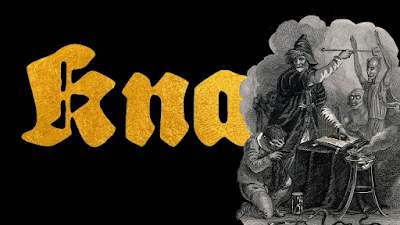THE WIZARD
This is a classic wizard. You don't hold with any of that modern nonsense - the classics will do just fine. I tried to stick close to the iconic wizard spells and a general feeling of sage-y-ness.
A huge debt is owed to the sage by Caput Capraem, and I used some wording from here.
Sadly I was unable to cut down the volume of stuff required for a wizard class and as such this class is two pages larger than any other class, at 4 pages in total! The weight of those two extra pages presses down upon my chest like the black dog itself.
That said, I'm happy that the whole wizard class and spell list can be handed to a player with just 2 sheets of paper, even including a reminder of how Magic Dice works. Very nice and easy to use at the table, especially if you're rolling up a new random character or introducing a new player.
VARIANT: OBJECTS OF POWER
Objects of Power can be anything. They are often carved with sigils and runes, blessed, or infused with magical power. Each Object of Power holds 1 spell, and takes up 1 inventory slot. You need 1 Object of Power for each spell you know. You can roll on this table to figure out what the Object of Power is for each spell.
- Scroll or small spellbook
- Wand
- Small human effigy. Could be made of cloth, clay, or sticks.
- Hand of Glory (Pickled left hand from a hanged murderer)
- Ornate rusted compass, lantern, skeleton key or other old item
- A relic like a Saint's fingerbone or a bottle of soil from a Saint's grave
- Carved stone idol
- Witch stone (AKA Adder Stone or Snake Egg, a glassy stone with a hole through it)
- Witch bottle (Salt-glazed stoneware jug with rosemary, needles and red wine)
- Runestone
- Carnelian flame (A red gemstone in the shape of a flame)
- Charon's Obol (A penny for the ferryman)
- Silver mirror
- Cherished keepsake or reminder of your past
- Smoking pipe
- Animal body part (like a lucky rabbit's foot, a rat's skull carved with sigils, etc)
- Seal of Solomon (an amulet or scroll bearing a hexagram shape)
- Large bracelet of intertwined snakes
- A bag of ingredients, mushrooms and powders
- Gris-gris (A small cloth bag inscribed with verses from one of your ancestors)


No comments:
Post a Comment